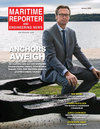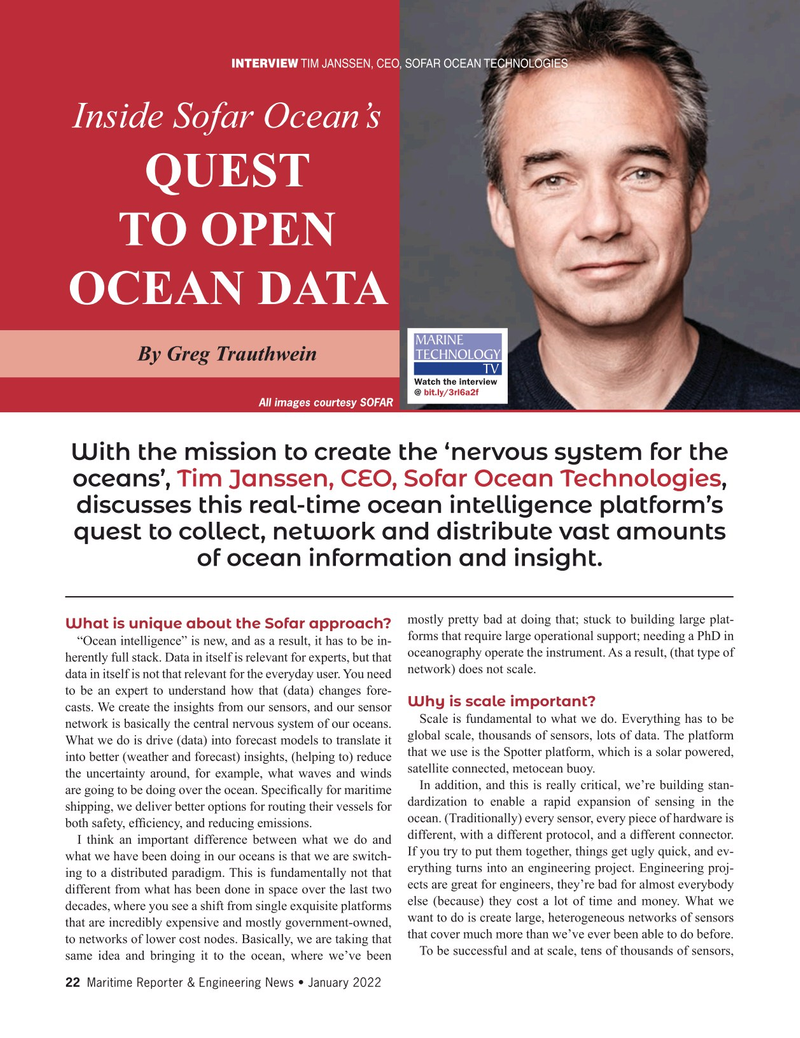
Page 22: of Maritime Reporter Magazine (January 2022)
The Ship Repair & Conversion Edition
Read this page in Pdf, Flash or Html5 edition of January 2022 Maritime Reporter Magazine
INTERVIEW TIM JANSSEN, CEO, SOFAR OCEAN TECHNOLOGIES
Inside Sofar Ocean’s
QUEST
TO OPEN
OCEAN DATA
MARINE
TECHNOLOGY
By Greg Trauthwein
TV
Watch the interview @ bit.ly/3rl6a2f
All images courtesy SOFAR
With the mission to create the ‘nervous system for the oceans’, Tim Janssen, CEO, Sofar Ocean Technologies, discusses this real-time ocean intelligence platform’s quest to collect, network and distribute vast amounts of ocean information and insight.
mostly pretty bad at doing that; stuck to building large plat-
What is unique about the Sofar approach?
forms that require large operational support; needing a PhD in “Ocean intelligence” is new, and as a result, it has to be in- oceanography operate the instrument. As a result, (that type of herently full stack. Data in itself is relevant for experts, but that network) does not scale.
data in itself is not that relevant for the everyday user. You need to be an expert to understand how that (data) changes fore-
Why is scale important?
casts. We create the insights from our sensors, and our sensor
Scale is fundamental to what we do. Everything has to be network is basically the central nervous system of our oceans.
What we do is drive (data) into forecast models to translate it global scale, thousands of sensors, lots of data. The platform that we use is the Spotter platform, which is a solar powered, into better (weather and forecast) insights, (helping to) reduce the uncertainty around, for example, what waves and winds satellite connected, metocean buoy.
In addition, and this is really critical, we’re building stan- are going to be doing over the ocean. Speci? cally for maritime dardization to enable a rapid expansion of sensing in the shipping, we deliver better options for routing their vessels for ocean. (Traditionally) every sensor, every piece of hardware is both safety, ef? ciency, and reducing emissions.
I think an important difference between what we do and different, with a different protocol, and a different connector.
If you try to put them together, things get ugly quick, and ev- what we have been doing in our oceans is that we are switch- ing to a distributed paradigm. This is fundamentally not that erything turns into an engineering project. Engineering proj- different from what has been done in space over the last two ects are great for engineers, they’re bad for almost everybody else (because) they cost a lot of time and money. What we decades, where you see a shift from single exquisite platforms that are incredibly expensive and mostly government-owned, want to do is create large, heterogeneous networks of sensors that cover much more than we’ve ever been able to do before.
to networks of lower cost nodes. Basically, we are taking that
To be successful and at scale, tens of thousands of sensors, same idea and bringing it to the ocean, where we’ve been 22 Maritime Reporter & Engineering News • January 2022
MR #1 (18-33).indd 22 1/6/2022 2:49:01 PM

 21
21

 23
23
